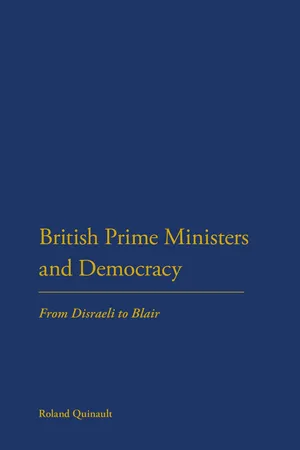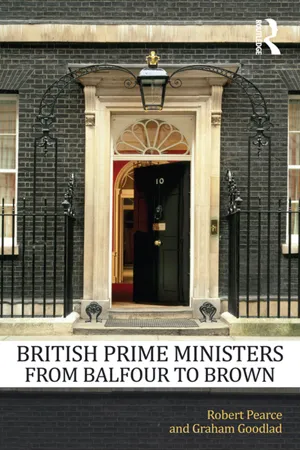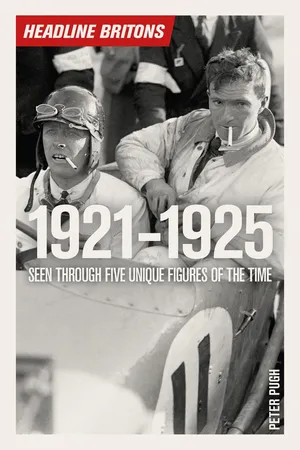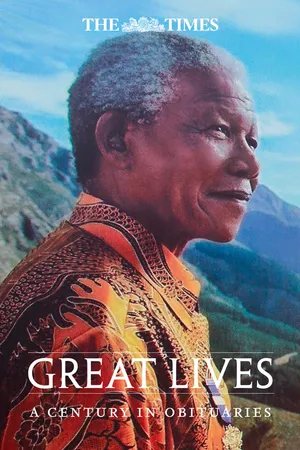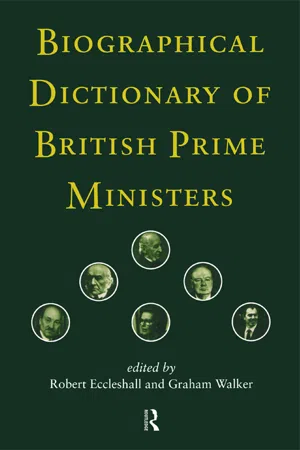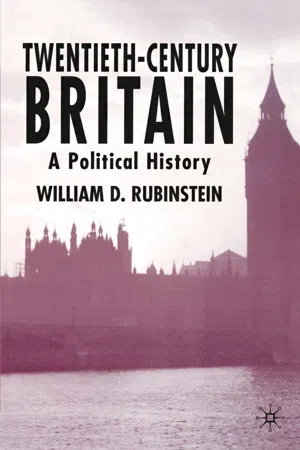History
David Lloyd George
David Lloyd George was a prominent British statesman who served as Prime Minister during World War I. He was known for his leadership in implementing social reforms and for his role in the Treaty of Versailles negotiations. Lloyd George's tenure saw significant changes in British politics, including the expansion of the welfare state and the extension of voting rights to women.
Written by Perlego with AI-assistance
Related key terms
1 of 5
10 Key excerpts on "David Lloyd George"
- eBook - PDF
British Prime Ministers and Democracy
From Disraeli to Blair
- Roland Quinault(Author)
- 2011(Publication Date)
- Continuum(Publisher)
74 75 4 David Lloyd George I am one of the children of the people. – LLOYD GEORGE, 1909 1 Despite the ‘opportunism’ which is one of the temptations and necessities of office and now and again deflects every man from his course, I have always sincerely striven to do my best for the class from which I sprang. – LLOYD GEORGE, 1931 2 The most dynamic and influential British politician in the first quarter of the twentieth century was David Lloyd George. In the Edwardian era he was the leader of the radical Liberals and a reforming Chancellor of the Exchequer. During the First World War he spearheaded the nation’s war effort, first as Minister for Munitions, then as Secretary for War and finally as Prime Minister of a coalition government from December 1916. In that capacity he led Britain to victory and gained a landslide victory at the 1918 general election. That enabled him to play a key role in the post-war peace treaties and to preside over important reforms both in Britain and the Empire. But he was obliged to resign when the Conservatives withdrew from the coalition government in October 1922. He never held office again, although he remained an important and inspirational politician until his death in 1945. Lloyd George was the first British Prime Minister to proclaim his personal democratic credentials. He was proud of his humble Welsh origins and identi-fied himself with ordinary people, while he was largely antagonistic to the traditional political elite. Consequently, his contemporary admirers hailed him as ‘the people’s champion’ and his first biographer claimed that he would be regarded as one of the greatest democrats of history. 3 His friend, the newspaper proprietor George Riddell, observed in 1912 that Lloyd George said ‘what the mass of the people feel but cannot express’. 4 His critics, however, accused him of putting personal ambition before democratic principle: ‘On the platform he is a democrat; in office he is the veriest autocrat. - eBook - ePub
- Robert Pearce, Graham Goodlad(Authors)
- 2013(Publication Date)
- Routledge(Publisher)
4 David Lloyd George (1863–1945) Prime Minister: December 1916– October 1922‘This siren, this goat-footed bard, this half-human visitor to our age from the hag-ridden, magic and enchanted woods of Celtic antiquity.’Maynard Keynes, The Economic Consequences of the Peace1Though he was born in 1863, so that his formative years were Victorian, and though for a time he seemed identified with narrow causes like temperance and Welsh disestablishment, David Lloyd George now seems a surprisingly modern political figure, in a way that his contemporaries do not. Partly this is due to the series of sexual and financial scandals that beset him, and which have so many recent counterparts that they seem somehow contemporary; partly, also, to his determination to alleviate poverty, an issue almost as important now – the poor, like the rich, being always with us – as in the first quarter of the twentieth century. Similarly, his political style seems distinctly modern. Here was no primus inter pares but a presidential leader, complete with a bevy of personal advisers: a man who liked to cut a dash on the national and international stages, always conscious of the need to influence the media. Belying his years, he was a person of great flexibility of mind. He adapted more successfully than any other British politician to the transition from peace to war in 1914, just as he was, in the 1920s, the first politician to espouse Keynesian economic policies. Though the office of premier had an aura of solemnity about it, Lloyd George often seemed a fresh and even playful figure, a rebel within the establishment. Even his irreverent jokes are still funny.2Yet if few doubt that Lloyd George was a man of enormous ability and energy, and could charm the birds from the trees, that is where consensus ends. To contemporaries he was a remarkably controversial figure, and he remains so to historians. What part did principle play in his career, what part opportunism? More specific questions must also be asked. Why did he become Prime Minister in December 1916? Was he motivated by patriotism, in that the war desperately needed a new energetic impulse, or did he indulge in unscrupulous intrigue against the honourable H.H. Asquith out of ambition? We also have to ask whether he was really, as his supporters insisted, ‘the man who won the war’, and what he achieved by carrying on a coalition into the equally momentous and challenging years of peace. - eBook - ePub
- Peter Pugh(Author)
- 2017(Publication Date)
- Icon Books(Publisher)
CHAPTER 5
David Lloyd George – A COUNTRY FIT FOR HEROES
D avid Lloyd George was perhaps the most unconventional of all British prime ministers in his background, character, outlook and policies. There was a highly adventurous, buccaneering quality about his six years in the premiership, between December 1916 and October 1922. Contemporaries were entranced, dazzled, astounded, impressed, alarmed and shocked by his behaviour and attitudes. One thing was certain: Lloyd George could never be ignored. He had emerged as a prominent and vociferous politician at the time of the Boer War in South Africa from 1899 to 1902 and continued to be respected or feared until the Second World War.Although he was born in Manchester, Lloyd George was brought up in rural Wales in humble circumstances and his Welsh background was vitally important in his life. He always spoke Welsh in his family circle and would even discuss high policy in Welsh on occasion, as with the deputy secretary of the Cabinet, Thomas Jones. Lloyd George was devoted to Wales and, while he rose to become a statesman of world stature, he never forgot his homeland and frequently returned there for relaxation. The deep influence of his early years in rural, Nonconformist Wales was revealed in his sometimes radical views, which were influenced by his dislike of landowners and inherited wealth; he did not fully comprehend urban radicalism and the more extreme manifestations of socialism. As a young man, he was ruthlessly determined to advance his career. His attitude is illustrated in one of his early letters to his future wife:My supreme idea is to get on. To this idea I shall sacrifice everything – except I trust honesty. I am prepared to thrust even love itself under the wheels of my Juggernaut, if it obstructs the way ... Believe me ... and may Heaven attest the truth of my statement – my love for you is sincere & strong. In this I never waver. But I must not forget that I have a purpose in life. And however painful the sacrifice I may have to make to attain this ambition I must not flinch – otherwise success will be remote indeed. - eBook - ePub
- (Author)
- 2015(Publication Date)
- Times Books(Publisher)
David Lloyd George
National leadership in war and peace. A pioneer of social reform. 26 March 1945The death of Earl Lloyd George of Dwyfor, which is announced on another page, marks the loss of one of the most controversial and commanding figures in British political life. Though for many years he had been out of office, he left an indelible mark on his country’s history both as a protagonist of social reform and as an indomitable leader during the war of 1914–18.The Right Hon. David Lloyd George, pc, om , first Earl Lloyd George of Dwyfor, and Viscount Gwynedd, of Dwyfor in the county of Caernarvon, in the Peerage of the United Kingdom, was born in Hulme, Manchester, on January 17, 1863. His father, William, came of a stock of substantial farmers in South Wales, but, preferring books to the plough, left the farm and became a wandering missionary of education, teaching in many places, of which Manchester was the last. His mother was a Lloyd, daughter of a Baptist minister who lived at Llanystumdwy, near Criccieth, in Caernarvonshire. The father died when he was 42, leaving the mother to bring up David, then a baby of 18 months, a daughter, who was older, and another son, who was born posthumously. Hearing of her plight her brother, Richard Lloyd, at once left his workshop – he was a master bootmaker – and took his sister and her children back to live with him at Llanystumdwy. He treated his sister’s children as his own, and sent them to the village school. David at school is said to have been quick rather than industrious, and his best subjects were geography and mathematics.Start as a LawyerThe Georges had known Mr Goffey, a Liverpool solicitor, and in the family councils about the boy’s future it was finally decided, thanks mainly to his mother’s insistence, to make him a lawyer. At 16 he was articled to a firm of solicitors in Portmadoc. Five years later he had started as a solicitor on his own account at Criccieth, to which the family had by then removed, and his uncle’s back parlour was his first chambers. He began to get work, and in 1885 he and his younger brother William had offices in the main street of Portmadoc. Three years later – just after his twenty-fifth birthday – the young solicitor was doing well enough to marry Margaret Owen, who belonged to a prosperous yeoman family just outside Criccieth. The marriage was happy and helpful. - Robert Eccleshall, Graham Walker(Authors)
- 2002(Publication Date)
- Routledge(Publisher)
David Lloyd George, First Earl of Dwyfor
Born 17 January 1863, second child of William George and Elizabeth Lloyd. Educated at Llanystumdwy National School. Married (1) 1888 Margaret Owen (died 1941); (2) 1943 Frances Stevenson (died 1972). MP for Caernarfon Borough 1890–1945. President of the Board of Trade 1905–8; Chancellor of the Exchequer 1908–15; Minister of Munitions 1915–16; Secretary of State for War 1916; Prime Minister 1916–22. Left Commons and ennobled 1945. Died 26 March 1945.In both peace and war David Lloyd George was the central figure of British parliamentary life in the first quarter of the twentieth century. This achievement was the more remarkable in that he was a Welsh ‘outsider’ in a world dominated by the networked products of fee-paying English education. Although he had been born in Manchester, Lloyd George was brought up in rural north Wales, an environment which conditioned in him firm opposition to Anglicanism, land privileges and squirearchical control. His early political life took shape during the reawakening of Welsh national identity and cultural self-confidence in the last quarter of the nineteenth century; this was the backdrop to his by-election victory in Caernarfon Borough in 1890, a parliamentary seat he held for fifty-five years. In the Commons in the early years of his career his commitment was first to Welsh causes and second to the Liberal party. A reputation as a ‘maverick’, which was to accompany Lloyd George throughout his political life, was forged in these early days out of an ‘undisciplined’ backbench record and a high profile, and politically risky, opposition to the Boer War. Nevertheless, as the premier representative of an almost entirely Liberal Wales in 1906, he secured ministerial office. Thereafter his horizon widened well beyond distinctively Welsh causes, although his limited experience of urban and industrial conditions disadvantaged him in relation to matters of labour unrest and employer-worker conflict in the large industries such as coal-mining.- eBook - ePub
The Age of Lloyd George
The Liberal Party and British Politics, 1890-1929
- Kenneth O. Morgan(Author)
- 2021(Publication Date)
- Routledge(Publisher)
A common theme in all these issues was the personal involvement of the Prime Minister. After his return from Paris in July 1919, he increasingly resembled a kind of minister of all departments, assuming each portfolio in turn and throwing traditional forms of Cabinet responsibility and collective participation to the winds. It is this period that has led some historians to see Lloyd George as inaugurating a new era of ‘Prime Ministerial government’. 3 Nowhere were these new tendencies more apparent than in the realm of labour policy, where he grappled manfully, and on the whole successfully, with the threat of a general strike. In an industrial world totally transformed by the war years, with the trade unions infinitely more powerful, and with a slump in the staple industries, there was a persistent atmosphere of crisis. In particular, pressures for ‘direct action’ became widespread in the trade union movement, especially among the miners. The government appeared to meet this with a stem front, none more so than Churchill, now moving rapidly to the extreme right on domestic issues. Once a leading advocate of ‘social radicalism’, the architect of labour exchanges and of social insurance before 1914, a champion of radical measures like nationalization of the railways as recently as 1919, Churchill was now a belligerent and uncompromising opponent of labour. The open sympathy of many Labour leaders with the revolutionary regime in Russia added force to his appeals to popular prejudice against the ‘red peril’. Yet, in general, neither side wanted a class war. Churchill’s belligerence was toned down by a government which passed a notable series of social reforms, including Addison’s Housing Act of 1919 and the introduction of unemployment insurance on a general scale in 1920. On the Labour side, most trade union leaders, men like Smillie and Thomas, basically sought conciliation - eBook - PDF
A Century of Premiers
Salisbury to Blair
- D. Leonard(Author)
- 2015(Publication Date)
- Palgrave Macmillan(Publisher)
His popularity in Wales and even in his own constituency slumped, as did his standing in the Liberal Party, where the Liberal Imperialists, led by Rosebery, Asquith and Haldane, enthusiastically backed the Salisbury government, while the party leader, Campbell-Bannerman, struggled with great difficulty to maintain a middle position. It was only after the war was over, and tempers had cooled, that Lloyd George was accorded respect for the courage he had shown and came increasingly to be recognised as the effective leader of the radical wing of the party. His attitude to the war, however, was widely misun- derstood. It was not based on pacifism, nor on opposition to the main- tenance, or even the expansion, of the British Empire. His essential objection was to the bullying of small nations by larger ones, and his attitude to the German invasion of Belgium in 1914 could therefore be seen as consistent with his position in 1899 rather than in conflict with it, as it has appeared to many. In the years following the war, Lloyd George’s parliamentary reputation grew steadily. He proved a resourceful opponent of Balfour’s 1902 Education Act and – together with Asquith – led the Liberal attack against Chamberlain’s tariff reform proposals which were the prime cause of the disintegration of the Balfour government. It was therefore no surprise that Campbell Bannerman chose him as a member of his Cabinet when a Liberal government was formed in December 1905. Most of the senior posts went to Liberal Imperialists, and C.B. sought to balance this by appointing Lloyd George, then aged 43, as President of the Board of Trade. - eBook - PDF
Twentieth-Century Britain
A Political History
- William D. Rubinstein(Author)
- 2017(Publication Date)
- Bloomsbury Academic(Publisher)
Many Tories were perfectly happy with this arrangement in the long term as well as the short term, and hoped that a Lloyd George-led Coalition would con-tinue indefinitely. They saw in Lloyd George the reincarnation of Joseph Chamberlain, the fiery radical Liberal who became the arch-imperialist Unionist and a supreme Tory icon. (Lloyd George was acutely conscious of the parallel.) They also saw in Lloyd George one of the few men in politics who could stem the tide of Bolshevism and socialism then sweeping across Europe. This would, they feared, inevitably reach Britain, where only Lloyd George possessed either the charisma or the credibility among the working classes to stem the extreme left-wing flow. Lloyd George, for his part, had worked extremely well with Bonar Law and, indeed, with the Tories as a whole during the war (much better than with Asquith). As noted, Lloyd George had flirted with a grand coalition as early as 1910, despite his radical rhetoric. Only a few major issues now squarely separated the Unionists and Lloyd George’s Liberals, the most important being tariff reform. In particular (as will be discussed below) the previously central question which divided the parties, that of Ireland, was in the process of being resolved, albeit with difficulty. Most leading Unionists and Lloyd George Liberals – the ‘first eleven’ as they were increasingly dubbed (from cricket terminology) – knew and respected one another. Men like Balfour, Curzon, Austen Chamberlain, and F.E. Smith on the Tory side, and Churchill, Addison, Isaacs, and Montagu on the Liberal side saw a mutuality of talent and, increasingly, of interest and outlook which generally went beyond the wishes of their backbenchers. Nevertheless, for both sides this arrangement was also one fraught with potential difficulties. - eBook - PDF
After Number 10
Former Prime Ministers in British Politics
- K. Theakston(Author)
- 2010(Publication Date)
- Palgrave Macmillan(Publisher)
Some of his impact was negative, in that he was a bogeyman to his rival political leaders, haunting their minds and their political calculations as they manoeuvred to thwart him and keep him out. Baldwin and MacDonald ‘get on together’, commented one insider in the late 1920s ‘because they both hate and fear [Lloyd George]. He is rarely for long out of their minds.’ 8 When MacDonald, the Labour leader, stayed at Chequers, the prime min- ister’s official country residence, he would have Lloyd George’s photograph taken down and put away in a cupboard. Baldwin defaced photographs of him in his private photo album. Lloyd George had a low opinion of them, and there was a strong mutual antipathy towards Neville Chamberlain too. He may have been ‘the man who won the war’, but his political opponents did their best to exploit the problems and broken promises of the years after 1918. Much of the politics of the 1920s were a reaction against Lloyd George – his methods, record, policies and personality. Ideas about new coalitions or alliances, dividing or breaking up the estab- lished parties, seemed never far from his thoughts. ‘I am working for a break 2 or 3 years hence after we have formed a Centre Party with a strong progressive bias’, he said soon after losing power. These dreams never mate- rialised, but options were kept open and feelers put out to left and right at various times, hoping to attract moderate Labour and progressive Con- servatives, and he sought to exploit whatever opportunities came his way as the tectonic plates of the party system groaned and shifted, with five elections in nine years (1922–31) and two periods of minority Labour gov- ernment (1924 and 1929–31). The underlying problem was that his polit- ical space was more and more squeezed as the Liberals lost out to Labour and the Conservatives and as two-party politics was restored. - eBook - PDF
A Short History of the Liberal Party
The Road Back to Power
- C. Cook(Author)
- 2010(Publication Date)
- Palgrave Macmillan(Publisher)
The new head of the party organisation was Sir Herbert Samuel. It was an inspired choice, for Samuel was one of the few Liberals acceptable to all sections of the party, since during the bitter internal quarrels in the party he had been High Commissioner in Palestine. The choice of Samuel to head the party machine was the first step towards revival. But Lloyd George’s greatest contribution was in the field of policy. During 1925, with Asquith still leader of the party, Lloyd George had poured money and resources into devising and producing new Liberal policies – even though few Liberals except Lloyd George and his associates took much part in their formulation. The first of the new policies – the land scheme – had already been published in October 1925. It had been greeted with mixed feelings. The report of the ‘Land Inquiry Committee’, published in book form as Land and the Nation, but popularly known as the Green Book, aroused criticism, both of its contents and of the way in which it appeared. 2 Further opposition, from candidates and Liberal Associations, flared when it was announced that Lloyd George had founded a new organisation, the Land and Nation League, to campaign for the implementation of the Green Book. Despite opposition to both his methods and his proposals, Lloyd George had carried on regardless. His next major contribution was in the field of unemployment, where a ‘Liberal Industrial Inquiry’ had been set up in 1925. A remarkable team of politicians and economists, Lloyd George Again: 1926–1931 107 including E.D. Simon, W.T. Layton, J.M. Keynes, Ramsay Muir, Herbert Samuel, Philip Kerr, Hubert Henderson and Lloyd George himself, had collaborated in this project. The fruit of their work was published as the first ‘Yellow Book’, Britain’s Industrial Future, in February 1928. As Robert Skidelsky comments, the far-reaching proposals for government planning which it advocated were well in advance of anything else in existence at the time.
Index pages curate the most relevant extracts from our library of academic textbooks. They’ve been created using an in-house natural language model (NLM), each adding context and meaning to key research topics.
